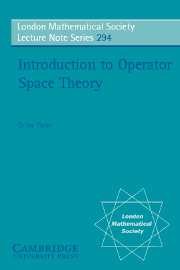0 - Introduction
Published online by Cambridge University Press: 05 October 2013
Summary
The theory of operator spaces is very recent. It was developed after Ruan's thesis (1988) by Effros and Ruan and Blecher and Paulsen. It can be described as a noncommutative Banach space theory. An operator space is simply a Banach space given together with an isometric linear embedding into the space B(H) of all bounded operators on a Hilbert space H. In this new category, the objects remain Banach spaces but the morphisms become the completely bounded maps (instead of the bounded linear ones). The latter appeared in the early 1980s following Stinespring's pioneering work (1955) and Arveson's fundamental results (1969) on completely positive maps. We study completely bounded (in short c.b.) maps in Chapter 1. This notion became important in the early 1980s through the independent work of Wittstock [Wit1–2], Haagerup [H4], and Paulsen [Pa2]. These authors independently discovered, within a short time interval, the fundamental factorization and extension property of c.b. maps (see Theorem 1.6).
For the reader who might wonder why c.b. maps are the “right” morphisms for the category of operator spaces, here are two arguments that come to mind: Consider E1 ⊂ B(H1) and E2 ⊂ B(H2) and let π: B (H1) → B(H2) be a C*-morphism (i.e. a *-homomorphism) such that π(E1) ⊂ E2. Then, quite convincingly, u = π∣E1 : E1 → E2 should be an “admissible” morphism in the category of operator spaces. Let us call these morphisms of the “first kind.”
- Type
- Chapter
- Information
- Introduction to Operator Space Theory , pp. 1 - 14Publisher: Cambridge University PressPrint publication year: 2003



